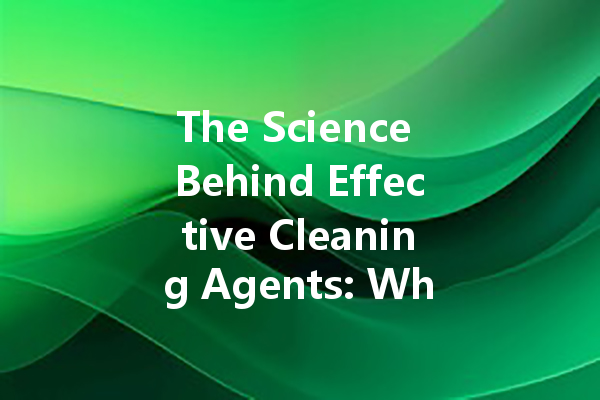Cleaning agents play a crucial role in maintaining hygiene and cleanliness in our homes, workplaces, and public spaces. Understanding the science behind these products can help consumers make informed decisions, ensuring they choose the right agents for specific cleaning tasks. In this article, we will explore the components, functionality, and innovations that define effective cleaning agents.
What Are Cleaning Agents?
Cleaning agents, also known as detergents or cleaners, are substances used to remove dirt, grime, and other unwanted materials from surfaces. They come in various forms, including liquids, powders, and sprays, and are composed of multiple active ingredients that work together to achieve cleanliness. Common types of cleaning agents include all-purpose cleaners, disinfectants, detergents, and solvents tailored for specific surfaces or tasks.
The Key Components of Cleaning Agents
The effectiveness of a cleaning agent largely depends on its chemical composition. Here are some critical components that contribute to its cleaning power:
Surfactants
Surfactants, or surface-active agents, are essential ingredients in cleaning agents. They lower the surface tension of water, allowing it to spread and penetrate surfaces more effectively. Surfactants work by breaking down the bonds between dirt particles and the surface, making it easier to rinse away grime. They are categorized into anionic, cationic, nonionic, and amphoteric surfactants, each with specific cleaning properties and applications.
Builders
Builders are ingredients that enhance the cleaning efficiency of surfactants. They work by softening water, which improves the surfactant’s ability to remove dirt and stains. Common builders include phosphates, citrates, and zeolites. These substances bind to calcium and magnesium ions in hard water, preventing them from interfering with the cleaning process.
Solvents
Solvents are used to dissolve dirt and grease, allowing for effective cleaning. They can be water-based or non-water-based, with water being the most commonly used solvent due to its availability and safety. Non-water-based solvents, such as alcohol or acetone, are often incorporated into cleaning agents to tackle tougher stains or residues that water cannot remove alone.
Fragrances and Dyes
While not essential to the cleaning process, fragrances and dyes enhance the user experience. Fragrances give cleaning products a pleasant scent, making the cleaning process more enjoyable, while dyes help to identify the product and indicate its purpose.
How Cleaning Agents Work
Understanding how cleaning agents work can explain their effectiveness in achieving cleanliness:
Dirt Removal
When a cleaning agent is applied to a surface, surfactants work to lift dirt, oil, and stains away from the surface. They surround these particles and reduce the forces holding them in place, allowing them to be easily wiped or rinsed away.
Disinfection
Many cleaning agents also have disinfecting properties. Disinfectants contain specific chemicals that target and kill harmful microorganisms like bacteria, viruses, and fungi. The active ingredients in disinfectants often work by damaging the cell walls of these pathogens, effectively neutralizing their threat.

Stain Removal
For stubborn stains, cleaning agents may require specific formulations that target particular substances. Enzymatic cleaners, for example, use enzymes that break down proteins, fats, or carbohydrates, making it easier to remove stains from surfaces, fabrics, or carpets.
Innovations in Cleaning Agents
The cleaning agent industry is continually evolving to meet consumer demands for efficiency, safety, and environmental responsibility. Here are some notable innovations:
Eco-Friendly Formulations
With growing awareness about environmental sustainability, many manufacturers are developing eco-friendly cleaning agents. These products often contain biodegradable ingredients and avoid harmful chemicals, ensuring that they are safer for the environment.
Probiotic Cleaners
A newer trend in cleaning agents is the introduction of probiotic cleaners that utilize beneficial bacteria to fight harmful germs. These products promote a healthier environment by outcompeting harmful bacteria for resources, rather than simply killing them.
Smart Cleaning Agents
Advancements in technology have also led to the development of smart cleaning agents that can indicate when a surface is clean. Some products change color upon contact with dirt, providing visual confirmation of cleaning effectiveness.
Choosing the Right Cleaning Agent
When selecting a cleaning agent for your needs, consider the following:
Conclusion
The science behind effective cleaning agents reveals a complex interplay of ingredients that work together to simplify our cleaning tasks. With a solid understanding of these components and innovations, consumers can make informed choices that meet their cleaning needs, all while promoting safety and sustainability. As the cleaning industry continues to evolve, keeping an eye on advancements will ensure you stay ahead in maintaining a cleaner and healthier environment.
